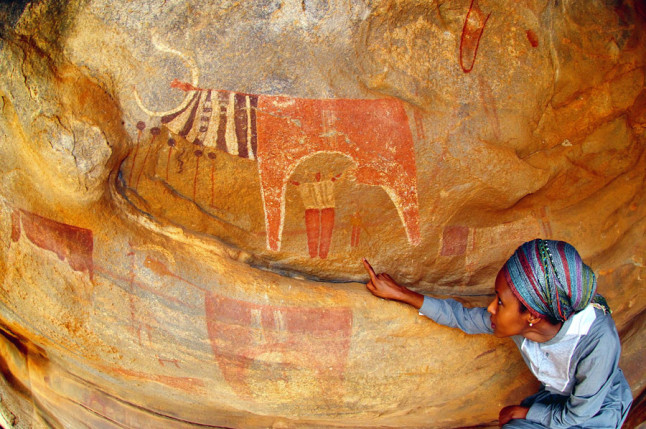June 2, 2015
Meet Sada Mire:
the First Somali
Archeologist
known to the World
Somalia sits on the horn of Africa with the longest coastline on the continent’s mainland, while its capital city Mogadishu is known as the ‘white pearl’ of the Indian Ocean. In antiquity, Somalia is said to be “among the most probable locations of the fabled ancient Land of Punt;” in addition, it was an important commercial centre with ancient relations. Its long-distance trade by sea and camel caravan gave birth to a multi-cultural society with communities on the coast.
Somalia’s rich and ancient cultural heritage and treasure has been overshadowed by years of conflict and unrest. Undertaking the challenge of discovery to expose Somali’s cultural and archeological heritage –to make known the region’s riches– is one committed extraordinary Somali woman. Dr Sada Mire is claimed to be the first and only active Somali woman archaeologist in Somaliland, a de facto state in Northern Somalia.
In 1991, young Mire and her mother fled the civil war in Somalia and ended up in Sweden. In 2007, she returned to her country of birth for the first time. Upon her return, she began to discover that Somalia had a lot of archeological heritage but was unexplored and disregarded; furthermore, it didn’t have a department organized for cultural heritage or antiquity. It was then that she set up and headed Somaliland’s Department of Antiquities, a branch of the Ministry of Culture and Tourism. She’s currently the director of tourism for Somaliland and the executive director of Horn Heritage Organisation(established since September 2011). Concurrently, she’s conducting post-doctoral research at University of Leiden specializing in the archaeology, ethnography and history of the peoples of North-East Africa, particularly Somalia, Ethiopia, Eritrea, Djibouti and Kenya. Her work focuses on the indigenous institutions and pre-Christian and pre-Islamic belief systems, material culture, (rock) art, rituals, practices and landscapes.
When asked why she chose to pursue a career in archeology, Mire explains how her career was aspired from a need to understand and learn African history. “After my study in Scandinavian prehistory, I started to wonder and wanted to learn my own history so I went on to study archeology,” she says. While in school in Sweden, she recalls how while searching for books on African history, which was rare, she came across a sentence in one book that changed her life: “In order to write African history, we need to do archeological research”. Six years later she enrolled in archeology school in England (She obtained her Ph.D. in archaeology from University College London).
 Ever since, the story of Mire has been her dedication to discover ancient treasures and preserve Somalia’s heritage, which she considers is at risk of disappearing. For this reason and more, she has been tenaciously and through methodical fieldwork making notable archaeological discoveries in the Horn of Africa. In this way, despite various challenges, believing that ‘cultural heritage is a basic human need’, she’s been on a mission for years, to discover, document, preserve, and educate Somali’s heritage.
Ever since, the story of Mire has been her dedication to discover ancient treasures and preserve Somalia’s heritage, which she considers is at risk of disappearing. For this reason and more, she has been tenaciously and through methodical fieldwork making notable archaeological discoveries in the Horn of Africa. In this way, despite various challenges, believing that ‘cultural heritage is a basic human need’, she’s been on a mission for years, to discover, document, preserve, and educate Somali’s heritage.
In this archeological pursuit, Mire has been acknowledged for her various prehistoric findings: 5,000 year-old rock art at Dhambalin, revealing ancient writings from the Red Sea culture is only one of many notable discoveries. Moreover, during her public talks, she’s been calling attention to potential UNESCO world heritage sites. One such spotlighted site is the existence of the Masjid al-Qiblatayan of Zeila (in the ancient port city in the Awdal region of Somalia). The oldest mosque in Somalia with two qiblas (a semicircular niche in the wall of a mosque that indicates the direction that Muslims should face when praying), one facing Mecca and the other facing Jerusalem, established in the 7th century by the Prophet Mohammed on a stopover during his travel for refuge in Axum.
Prior to her discoveries, she admits how these heritage features were unknown to the world as well as many Somalis. Accordingly, she recognized how (many) Somalis were completely unaware of the existence and significance of archaeology. With that in mind, while grappling with the question of what cultural heritage means to Somalis, the lack of knowledge, it seems, has encouraged her to expose and educate Somali’s cultural heritage, first to Somalis and afterward to the world.
When educating, evidently conscious of the importance of building on existing knowledge, she points out how she uses and integrates local approaches; in this way, part of her process includes bringing in local people to try and talk about objects and monuments.
What’s more, recognizing the significance of mobile technology, and keeping in mind Somali’s ‘selective approach to technology’, she’s expressed focus on instituting digital preservation of heritage. All in all, eventually, she says her ultimate hope is that the discovery and archiving will not only have archeological importance and “enhance understanding about the prehistoric way of life across the region”, but also “help promote a sense of confidence and cultural pride in Somali’s”. Furthermore, underlining the power of archeology in understanding our identity, Mire reckons that “pride and dignity in knowing our heritage can be a basis for a collaborative approach to development in African nations.”
>via: http://africaspeaks4africa.org/meet-sada-mire-the-first-somali-archeologist-known-to-the-world/




Very intresting and inspiring! thank you!
Somali people are probably the most handsome people in the world and this lady’s beauty is something rather common to them. Kalisa from Rwanda.
Correction. Prophet Muhammed peace and blessings of Allah be upon him , did not travel to Africa , but some of his companions may Allah be pleased with them.